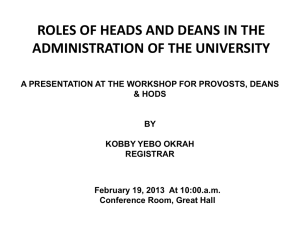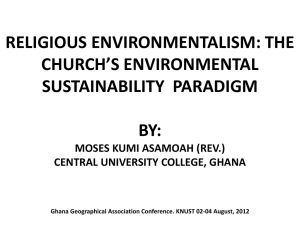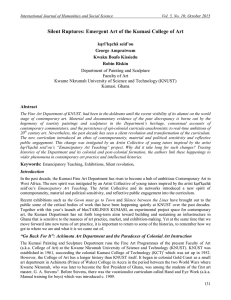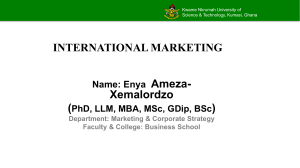establishment of central computer labs under hp digital village
advertisement
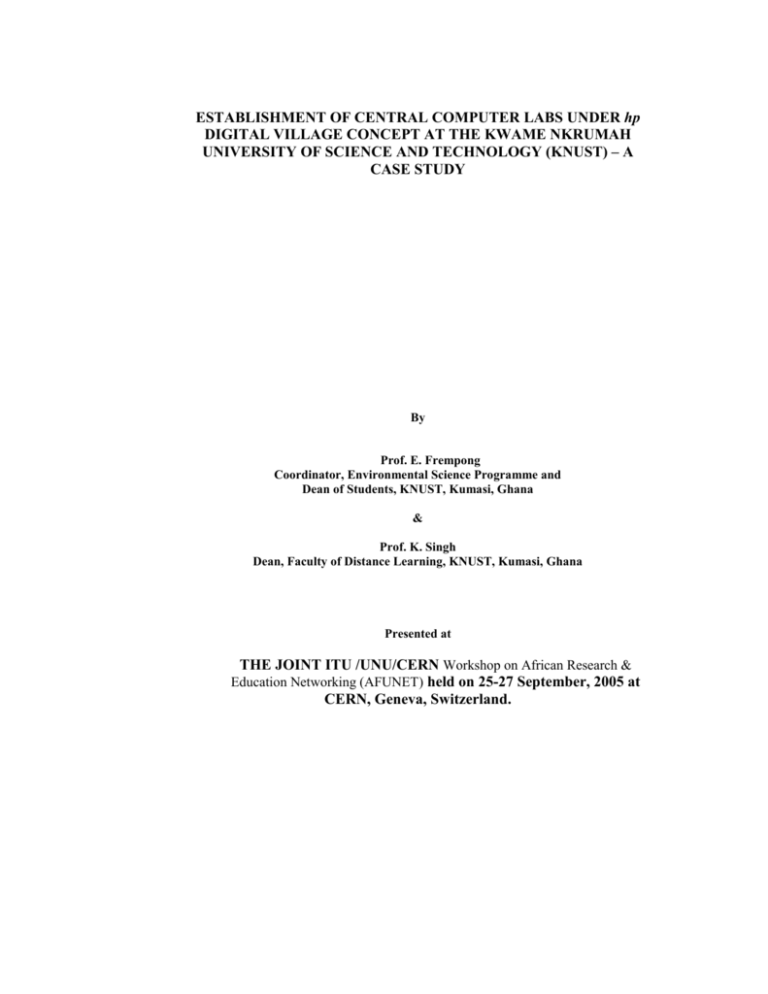
ESTABLISHMENT OF CENTRAL COMPUTER LABS UNDER hp DIGITAL VILLAGE CONCEPT AT THE KWAME NKRUMAH UNIVERSITY OF SCIENCE AND TECHNOLOGY (KNUST) – A CASE STUDY By Prof. E. Frempong Coordinator, Environmental Science Programme and Dean of Students, KNUST, Kumasi, Ghana & Prof. K. Singh Dean, Faculty of Distance Learning, KNUST, Kumasi, Ghana Presented at THE JOINT ITU /UNU/CERN Workshop on African Research & Education Networking (AFUNET) held on 25-27 September, 2005 at CERN, Geneva, Switzerland. ESTABLISHMENT OF CENTRAL COMPUTER LABS UNDER hp DIGITAL VILLAGE CONCEPT AT KNUST – A CASE STUDY Prof. E. Frempong Coordinator, Environmental Science Programme and Dean of Students, KNUST, Kumasi, Ghana Prof. K. Singh Dean, Faculty of Distance Learning, KNUST, Kumasi, Ghana SUMMARY This short paper covers the major steps taken by the Kwame Nkrumah University of Science and Technology for the ICT infrastructure development and towards the effective use of ICT at the University under HP digital village concept. It includes the network design for backbone connectivity which includes interconnection among various departments to the Network Operating Centre(NOC) using fiber optic technology, network costs, bandwidths requirement, ICT services offered to students and staff, and future planning/requirements. Abbreviation: hp - Hewlett-Packard 1.0 ABOUT THE UNIVERSITY The Kwame Nkrumah University of Science and Technology Kumasi was established by a Government Ordinance on 6th October 1951. It opened officially on 22nd January 1952, with 200 Teacher Training students. The University has within the short period of fifty (50) years of its existence become an important centre for the training of scientists and technologists not only for Ghana but also for other African countries. The main University is situated on a campus of about seven square miles (18 square kilometres) of undulating land and pleasant surroundings, about four miles (6 kilometres) away from the centre of Kumasi, the Ashanti Regional capital. The campus presents a panorama of beautiful and modern buildings interspersed with verdant lawns and tropical flora, which provide a cool and refreshing atmosphere congenial to academic studies. The University has within the short period of its existence become an important centre for the training of scientists and technologists not only for Ghana but also for other African countries and other countries especially of the European Union and North America. At the beginning of 2004/05 Academic year, the student population was about 16,146(4,622 Female and 11,524 Male) which may go beyond 20,000 in 2005/06 Academic year. Currently, the University has 580 academic staff, 95 senior administrative staff and 2,599 supporting staff. 1 The University has now been restructured into six colleges: Architecture and Planning Art and Social Sciences Agriculture and Natural Resources Engineering Health Sciences Science 2.0 NETWORK BACKBONE 2.1 HIGHLIGHTS OF MAJOR COMPONENTS OF hp DIGITAL VILLAGE (a) Establishment of central computer labs under hp digital village concept (Appendix 1) i. Main Library ii. KVCIT iii. Faculty of Science iv. Pharmacy (b) Wide Area Network (WAN) design for Fiber Optic Backbone Connectivity (Appendix 2) (c) Creation of Local Area network (LAN) by various departments (Appendix 1) (d) Two-way broadband internet access 2.2 TECHNICAL OVERVIEW OF WIDE AREA NETWORKING (WAN) 2.2.1 Fibre Optic Topology: The fibre optic cabling is dividing the KNUST campus into four (4) zones (Appendix 2). Zone 1: Administration, College of Art, Administration block 2, Library (Main Library, KVCIT). Zone 2: Agriculture, CCB, Agric Eng., IRNR, FEDS Zone 3: SMS, Chemistry, Biological Sciences. Zone 4: Physics, Engineering 1, Engineering 2, Social Sciences 2.2.2 HP 9304 Routing Switch at Pharmacy Block The HP 9304 Routing Switch, installed at the Pharmacy Block would serve as the central concentration point for all the remote sites. All remote sites connect to it directly using an independent fiber pair. The throughput between each remote site and the 9304 Router Switch is 200Mbps at full duplex. The 2 throughput between two sites would also be 200Mbps. This would provide a high performance as well as provide huge scalability (The 9304 is a Modular device and can take additional two 24 port fiber modules). In its existing configuration itself, the 9304 can accommodate at least 8 additional sites. Another option is to install Alcatel Asynchronous Transfer Mode(ATM) switch as suggested by Ghana Telecom(GT FASTnet). 2.2.3 Network Configuration – VLANs Each remote site would be a separate Network (subnet). All traffic to/fro from a site would be routed from the central 9304 Routing switch. This would result in clearly defined and secure networks. The 2524 manageable switches at the remote sites support Virtual LANs(VLANs) which would further secure and control the broadcast domain for the site. 2.2.4 Cisco 3640 Router at Pharmacy Block This contains a dual E1 controller, one of which would be connected to a NetModem broad band router combined with a satellite modem, network router, and network management software into one box. The NetModem is designed to facilitate dynamic bandwidth allocation and is highly suitable in terms of both Inbound and Outbound data rates. The second E1 controller would not be used immediately and would serve as a standby for future upgrade. The Cisco 3640 would run the Cisco IOS 12.0 which is the latest in Cisco range. It also has a bank of analog modems which would provide dial-in access to dial-up commuters who wish to access the KNUST network resources in a secure manner. 2.2.5 Cisco PIX Firewall at Pharmacy Block The Cisco PIX firewall is capable of supporting multiple Networks. An extra Fast Ethernet interface will be added which can be linked to a Demilitarized LAN to host the KNUST WEB and E-mail servers. The PIX firewall would be placed between the 9304M switch and the 3640 Router for maximum protection and security. 2.3 NETWORK COSTS Network costs consist of equipment, installation and recurrent monthly charges. The cost is based on: (1) Fibre Optic Cable and laying cost, the cost of the fibre link. (2) Cost of switches, Cisco Routers and Catalyst, 3Com Hub. (3) Backup link cost includes Wireless Inc. Radio access, copper backup link. (4) Monthly recurrent charges 3 (5) Maintenance and support services. The total cost of Fibre Network on KNUST was US$ 1,286,845.00. Out of this, KNUST’s contribution was US$286,845.00 and donation from HP was US$1,000,000.00. The University’s contribution was used for the following: Fibre Cables and Equipment: US$177,689.00 VSAT Equipment and connectivity: US$44,400.00 Switches, Transceivers, etc.: US$64,756.00 In addition to this, a number of 2524 manageable switches at the remote sites to support Virtual LANs(VLANs) and other material and technical support to create VLANs in various Departments/units were obtained. 2.4 BANDWIDTH REQUIREMENTS The KNUST Network Operating Centre (NOC) obtained two-way broadband internet access to connect more than 1,000 computers directly to the MAE – east internet backbone in Washington D.C. through a direct satellite link in September, 2002. It is currently hooked to the IDirect Satellite through a satellite dish provided by Afrinet Ghana Ltd., a Satellite Communications company in Accra. The Centre is on a 128/1024kbps shared link to the Internet at the cost of $4,823.72 every month for connectivity. In addition to this, an annual local regulation fee of US$2,000.00 is paid to National Communication Authority, Ghana for new VSAT equipment with 256/1024 kbps dedicated link to the internet. The approximate cost of this new connection is $8,000.00 every month. 2.5 DISTANCE LEARNING INITIATIVE The demand for higher education in terms of qualified applicants to various programmes run by the University is very high. A number of factors, including the limited classroom and laboratories etc. facilities available at the University have conspired to limit the number of trained professionals in Science and Technology graduates from the University. In order to help remedy the situation, a new Faculty of Distance Learning(FDL) has been established to deliver programmes of study both on-going and new ones from all colleges of the University in the distance learning mode through the use of a wide range of technologies e.g. Print, Multimedia(CD ROMS, Audio/Video cassettes etc.), TV Broadcast, Radio Broadcast, Video conferencing(IP based system), Video conferencing(ISDN based system), Web Enhanced(some materials on line), Web based(most learning takes placed on line). 4 The Faculty of Distance Learning comprises of two Departments: Centre for Distance and Continuing Education(CDCE) - Programmes Coordination Unit - Material Production Unit - Material Distribution Unit Kumasi Virtual Centre for Information Technology(KVCIT) - Software Development Unit - Hardware Maintenance and Repair Unit - Training Unit: - Academic Programmes Unit 2.5.1 Programmes/Courses offered by Faculty of Distance Learning i. ii. iii. 4-year B.Sc. (Applied Computer Science) RMIT/AVU Programme 2-year Diploma (Computer Science) RMIT/AVU Programme short courses a. Computer Literacy/Applications b. c. d. e. f. g. h. i. j. k. l. m. Certificate in Journalism IT Master Certificate Certificate in Business Communication in English Programming Languages (C++, Java, ASP, etc.) Basic Office Packages Introduction to Computers A+ Certification/Computer Hardware Web Design AutoCAD, ArchiCAD Networking Email Service and Internet Browsing Adobe PhotoShop, CorelDraw, Macromedia Flash and Fireworks 2.5.2 Services provided to outside Institutions/ Organisations 1. Primary, JSS and SSS Teachers Training seminar on introduction to computers, introduction to Internet and Meteorology organised by AVU(KNUST)from 11th July to 1st August, 1998. More than twenty five (25) teachers participated. 2. Elementary French for Beginners using "French in Action” December 1999 to June 2000. 3. Computer Training Workshop for fifty (50) Inspectors on Refresher course at the Police Training School, Kumasi September 2000. 5 4. Economics and Business Journalism Distance Learning Seminar for Professional Journalists and Journalists from Institute of Business and Financial Economic Journalism, Kumasi - October 4 - November 29, 2000. This Seminar was organized by the World Bank Institute(WBI) in collaboration with the African Virtual University and the Global Development Learning Network for the journalists in Ethiopia, Ghana, Kenya, Namibia, Nigeria, South Africa, Tanzania, Uganda and Zimbabwe with weekly three-hour sessions delivered through interactive television, with email, and internet linkages for discussion, writing assignments, and reading material. 5. Computer Literacy/Applications course for KNUST JSS Teachers – August 2001. 6. Computer Literacy/Applications course for about one hundred (100) students from Institute of Management Studies, Kumasi Centre – 2001. 7. Two (2) days' Computer Training for Agogo Presbyterian Nursing Training College in July, 2001. Twenty three (23) students were present. 8. Computer Literacy/Applications for JSS Leavers - 2002 – 2003. 9. Computer Training for about 20 staff from five(5) Satellite laboratories under community out-reach programme from Community Services Foundations (CSF) - Computer literacy/Applications Training in 2003 - Computer Literacy/Applications Training in 2004 10. Computer Literacy/Applications course 3rd District Science Technology Education Clinic for Girls (STME) from Ejisu Juaben District of Ghana Education Service - August 2004. 2.6 BASIC SERVICES OFFERED TO STUDENTS An ICT Centre has also been established and the following services are available for students. The first year students are charged $30 whilst the continuing students are charged $15 for a year. Service Internet Access Email Service File Sharing e-learning system ICT training Description Approximately 3 hours a week browsing Myname.faculty@knust.edu.gh 5MB for saving documents Chartrooms, discussion boards, course and staff information, course upload and assignment delivery systems Applications usage and software development options 6 2.7 UNIVERSITY INFORMATION TECHNOL OGY COMMITTEE (UITC) The University has an Advisory /Policy making University Information Technology Committee (UITC) under the Chairmanship of the Vice Chancellor to coordinate and oversee every aspect of ICT with the following objectives: - To initiate, promote and coordinate Information and Communications Technologies (ICT) facilities at KNUST. - To promote the innovative applications and uses of information and Communications Technologies in learning, teaching and research. - To advice the University on all IT related issues. 2.8 FUTURE PLANNING /REQUIREMENTS There is a need to develop a culture of work and organizational structure which takes advantage of the properties of the virtual or electronic work space, and students and staff need to be prepared for the proper use of the new technologies. To work out a checklist that would be required to implement ICT effectively within the University system i.e. - Policy - Technical - Human resource - Training requirement To promote intelligent use of ICT in teaching and learning. To make use of ICT to transform lectures from class room teaching (face to face) into web based presentation. To make proper use of ICT to manage, access, disseminate research information. To acquire course delivering tools ( WebCT, Blackboard, Ucompass etc.) and to make arrangements for course delivery services to host the on-line courses for distant learners. As the University has been able to establish a number of central computer pools under Hp Digital village concept and is also in the process of acquiring more PCs from different sources including local resources, growth of backbone to network each and every computer and expansion of bandwidth are key factors to meet the enormous demands of ICT at KNUST. 7 Appendix 1 SITE Science Pharmacy* SMS FEDS Computer* Biological Physics Chemistry Maths Optometry Biochemistry Engineering Agric IRNR Soc. Science College of Arts ILMAD IMME LIBRARY* KVCIT* Admin. 1&2 Planning Unit Finance Office No. of Network Points 120 168 96 120 93 53 40 48 6 15 15 0 9 0 10 0 0 50 150 10 10 10 Registered computers on KNUST LAN 40 50 10 60 10 8 8 0 0 4 15 0 9 0 10 0 0 29 29 10 10 10 No. of Networked computers in student Lab. 16 0 10 50 10 6 0 24 0 0 8 0 2 0 5 0 0 0 0 0 0 0 * hp Supported Labs 8 Approximated No. of Computers 56 50 40 95 30 16 13 24 0 4 110 15 20 10 30 8 8 60 150 23 10 10 No. of Registered Laptops (Lecturers) 14 15 3 4 2 2 2 2 2 2 7 2 4 1 3 1 1 0 0 0 0 0 No. of Registered Laptops (Students) 10 10 3 4 2 2 2 2 2 2 2 2 2 2 2 2 2 0 0 0 0 0 Standard EAI/TIA-568 EAI/TIA-568 EAI/TIA-568 EAI/TIA-568 EAI/TIA-568 EAI/TIA-568 EAI/TIA-568 EAI/TIA-568 EAI/TIA-568 EAI/TIA-568 N/A Not done Not done Not done Not done Not done Not done N/A N/A N/A Not done EAI/TIA-568 OPTIC FIBRE BACK-BONE 9
